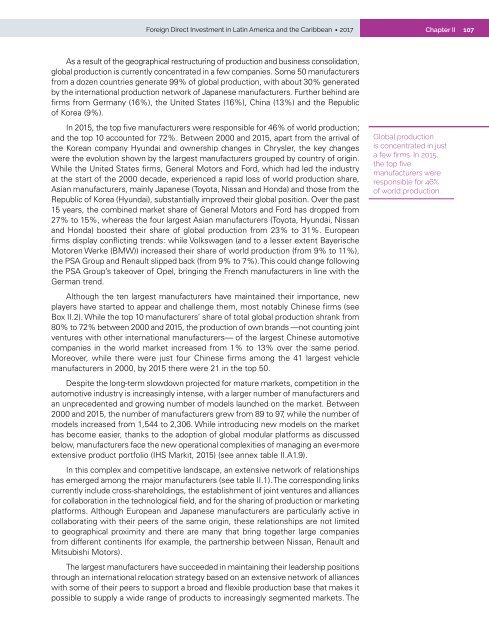Foreign Direct Investment in Latin America and the Caribbean 2017
This publication sets out and analyses the main foreign direct investment (FDI) trends in the countries of Latin America and the Caribbean. The 2017 edition shows that the region is at a difficult juncture. FDI inflows declined by 7.9% in 2016, to US$ 167.043 billion, representing a cumulative fall of 17.0% since the peak in 2011. The fall in commodity prices continues to affect investments in natural resources, sluggish economic growth in several countries has slowed the flow of market-seeking capital, and the global backdrop of technological sophistication and expansion of the digital economy has concentrated transnational investments in developed economies.
This publication sets out and analyses the main foreign direct investment (FDI) trends in the countries of Latin America and the Caribbean. The 2017 edition shows that the region is at a difficult juncture. FDI inflows declined by 7.9% in 2016, to US$ 167.043 billion, representing a cumulative fall of 17.0% since the peak in 2011. The fall in commodity prices continues to affect investments in natural resources, sluggish economic growth in several countries has slowed the flow of market-seeking capital, and the global backdrop of technological sophistication and expansion of the digital economy has concentrated transnational investments in developed economies.
Create successful ePaper yourself
Turn your PDF publications into a flip-book with our unique Google optimized e-Paper software.
<strong>Foreign</strong> <strong>Direct</strong> <strong>Investment</strong> <strong>in</strong> Lat<strong>in</strong> <strong>America</strong> <strong>and</strong> <strong>the</strong> <strong>Caribbean</strong> • <strong>2017</strong><br />
Chapter II<br />
107<br />
As a result of <strong>the</strong> geographical restructur<strong>in</strong>g of production <strong>and</strong> bus<strong>in</strong>ess consolidation,<br />
global production is currently concentrated <strong>in</strong> a few companies. Some 50 manufacturers<br />
from a dozen countries generate 99% of global production, with about 30% generated<br />
by <strong>the</strong> <strong>in</strong>ternational production network of Japanese manufacturers. Fur<strong>the</strong>r beh<strong>in</strong>d are<br />
firms from Germany (16%), <strong>the</strong> United States (16%), Ch<strong>in</strong>a (13%) <strong>and</strong> <strong>the</strong> Republic<br />
of Korea (9%).<br />
In 2015, <strong>the</strong> top five manufacturers were responsible for 46% of world production;<br />
<strong>and</strong> <strong>the</strong> top 10 accounted for 72%. Between 2000 <strong>and</strong> 2015, apart from <strong>the</strong> arrival of<br />
<strong>the</strong> Korean company Hyundai <strong>and</strong> ownership changes <strong>in</strong> Chrysler, <strong>the</strong> key changes<br />
were <strong>the</strong> evolution shown by <strong>the</strong> largest manufacturers grouped by country of orig<strong>in</strong>.<br />
While <strong>the</strong> United States firms, General Motors <strong>and</strong> Ford, which had led <strong>the</strong> <strong>in</strong>dustry<br />
at <strong>the</strong> start of <strong>the</strong> 2000 decade, experienced a rapid loss of world production share,<br />
Asian manufacturers, ma<strong>in</strong>ly Japanese (Toyota, Nissan <strong>and</strong> Honda) <strong>and</strong> those from <strong>the</strong><br />
Republic of Korea (Hyundai), substantially improved <strong>the</strong>ir global position. Over <strong>the</strong> past<br />
15 years, <strong>the</strong> comb<strong>in</strong>ed market share of General Motors <strong>and</strong> Ford has dropped from<br />
27% to 15%, whereas <strong>the</strong> four largest Asian manufacturers (Toyota, Hyundai, Nissan<br />
<strong>and</strong> Honda) boosted <strong>the</strong>ir share of global production from 23% to 31%. European<br />
firms display conflict<strong>in</strong>g trends: while Volkswagen (<strong>and</strong> to a lesser extent Bayerische<br />
Motoren Werke (BMW)) <strong>in</strong>creased <strong>the</strong>ir share of world production (from 9% to 11%),<br />
<strong>the</strong> PSA Group <strong>and</strong> Renault slipped back (from 9% to 7%). This could change follow<strong>in</strong>g<br />
<strong>the</strong> PSA Group’s takeover of Opel, br<strong>in</strong>g<strong>in</strong>g <strong>the</strong> French manufacturers <strong>in</strong> l<strong>in</strong>e with <strong>the</strong><br />
German trend.<br />
Although <strong>the</strong> ten largest manufacturers have ma<strong>in</strong>ta<strong>in</strong>ed <strong>the</strong>ir importance, new<br />
players have started to appear <strong>and</strong> challenge <strong>the</strong>m, most notably Ch<strong>in</strong>ese firms (see<br />
Box II.2). While <strong>the</strong> top 10 manufacturers’ share of total global production shrank from<br />
80% to 72% between 2000 <strong>and</strong> 2015, <strong>the</strong> production of own br<strong>and</strong>s —not count<strong>in</strong>g jo<strong>in</strong>t<br />
ventures with o<strong>the</strong>r <strong>in</strong>ternational manufacturers— of <strong>the</strong> largest Ch<strong>in</strong>ese automotive<br />
companies <strong>in</strong> <strong>the</strong> world market <strong>in</strong>creased from 1% to 13% over <strong>the</strong> same period.<br />
Moreover, while <strong>the</strong>re were just four Ch<strong>in</strong>ese firms among <strong>the</strong> 41 largest vehicle<br />
manufacturers <strong>in</strong> 2000, by 2015 <strong>the</strong>re were 21 <strong>in</strong> <strong>the</strong> top 50.<br />
Despite <strong>the</strong> long-term slowdown projected for mature markets, competition <strong>in</strong> <strong>the</strong><br />
automotive <strong>in</strong>dustry is <strong>in</strong>creas<strong>in</strong>gly <strong>in</strong>tense, with a larger number of manufacturers <strong>and</strong><br />
an unprecedented <strong>and</strong> grow<strong>in</strong>g number of models launched on <strong>the</strong> market. Between<br />
2000 <strong>and</strong> 2015, <strong>the</strong> number of manufacturers grew from 89 to 97, while <strong>the</strong> number of<br />
models <strong>in</strong>creased from 1,544 to 2,306. While <strong>in</strong>troduc<strong>in</strong>g new models on <strong>the</strong> market<br />
has become easier, thanks to <strong>the</strong> adoption of global modular platforms as discussed<br />
below, manufacturers face <strong>the</strong> new operational complexities of manag<strong>in</strong>g an ever-more<br />
extensive product portfolio (IHS Markit, 2015) (see annex table II.A1.9).<br />
In this complex <strong>and</strong> competitive l<strong>and</strong>scape, an extensive network of relationships<br />
has emerged among <strong>the</strong> major manufacturers (see table II.1). The correspond<strong>in</strong>g l<strong>in</strong>ks<br />
currently <strong>in</strong>clude cross-sharehold<strong>in</strong>gs, <strong>the</strong> establishment of jo<strong>in</strong>t ventures <strong>and</strong> alliances<br />
for collaboration <strong>in</strong> <strong>the</strong> technological field, <strong>and</strong> for <strong>the</strong> shar<strong>in</strong>g of production or market<strong>in</strong>g<br />
platforms. Although European <strong>and</strong> Japanese manufacturers are particularly active <strong>in</strong><br />
collaborat<strong>in</strong>g with <strong>the</strong>ir peers of <strong>the</strong> same orig<strong>in</strong>, <strong>the</strong>se relationships are not limited<br />
to geographical proximity <strong>and</strong> <strong>the</strong>re are many that br<strong>in</strong>g toge<strong>the</strong>r large companies<br />
from different cont<strong>in</strong>ents (for example, <strong>the</strong> partnership between Nissan, Renault <strong>and</strong><br />
Mitsubishi Motors).<br />
The largest manufacturers have succeeded <strong>in</strong> ma<strong>in</strong>ta<strong>in</strong><strong>in</strong>g <strong>the</strong>ir leadership positions<br />
through an <strong>in</strong>ternational relocation strategy based on an extensive network of alliances<br />
with some of <strong>the</strong>ir peers to support a broad <strong>and</strong> flexible production base that makes it<br />
possible to supply a wide range of products to <strong>in</strong>creas<strong>in</strong>gly segmented markets. The<br />
Global production<br />
is concentrated <strong>in</strong> just<br />
a few firms. In 2015,<br />
<strong>the</strong> top five<br />
manufacturers were<br />
responsible for 46%<br />
of world production.


















